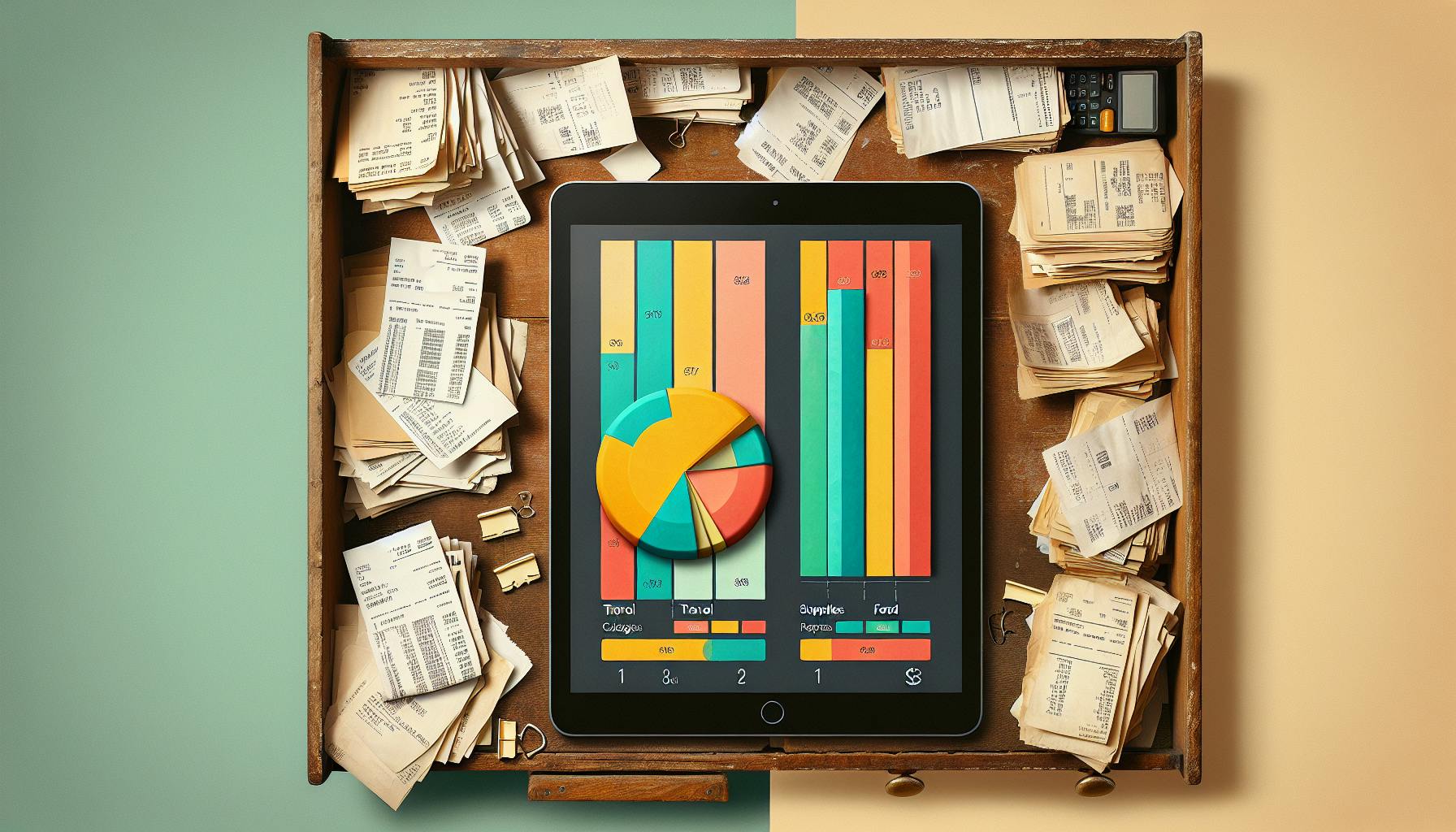Most website visitors would agree that analyzing data to optimize business performance is critically important, yet incredibly challenging.
Comparative analytics software promises accountants an easy way to benchmark, forecast, and reveal actionable insights across their subscription businesses' key metrics.
This guide compares features of the top subscription analytics tools - from integrations to reporting and more - to help accountants select the one that will best meet their subscription data analysis needs.
Introduction to Subscription Analytics for Accountants
As accountants, the subscription economy presents new opportunities and challenges for managing client finances. Recurring revenue models are attractive business models, with high growth potential. However, many accountants struggle to find software that can provide the necessary insights for handling subscription-based clients.
Subscription accounting requires tracking metrics like Monthly Recurring Revenue (MRR) and Customer Lifetime Value (CLV). They also need to monitor key performance indicators (KPIs) like subscriber churn rate, retention rate, acquisition costs, and more. Without the proper analytics, it's difficult to get a snapshot of a subscription business's finances.
Fortunately, several software platforms provide subscription analytics tailored for the accounting profession. By selecting an analytics solution that tracks revenue metrics, retention trends, and other SaaS metrics, accountants can better serve their subscription-based clients. With subscription data visualized in dashboards and reports, accountants gain greater financial visibility and can provide vital insight for growth.
The top platforms provide features like automated data integration, customizable reports, forecast modeling tools, cohort analysis, and benchmarking. Top solutions also integrate with accounting software like QuickBooks. This allows seamlessly monitoring client subscription data alongside more traditional financials.
Overall, evaluating options and selecting software with robust accounting-focused subscription analytics is key. The right platform empowers accountants to unlock the full potential of subscription-based businesses. Software with specialized accounting tools for tracking recurring revenues can drive smarter financial decisions and fuel sustainable client growth.
What software is used for analytics in finance?
Microsoft Excel is the predominant software used for financial analytics. With its robust calculations, charting, and pivot tables, Excel empowers finance professionals to analyze data, identify trends, create financial models, forecast growth, and generate valuable insights.
Many core financial tasks can be accomplished efficiently in Excel:
- Financial modeling - Build integrated financial statements, DCF models, sensitivity analysis, scenarios, and valuations leveraging Excel's formulas, formatting, auditing tools, and add-ins
- Reporting & visualization - Transform raw data into digestible reports, dashboards and charts to track KPIs and inform business decisions
- Budgeting - Streamline budget planning activities with Excel's worksheet structure, formula capabilities, and data organization features
- Analysis - Utilize pivot tables, regression analysis, What-If analysis, goal seek, and other analytics tools to dissect data and uncover hidden insights
Excel's functionalities cater directly to critical finance needs around calculations, analysis, reporting, and visualization. Its ubiquity across businesses and teams enables seamless collaboration. With the ability to automate workflows, connect external data sources, and scale to manager massive datasets with Power Pivot/Query, Excel delivers the flexibility today's finance teams require within a familiar interface. For these reasons, Microsoft Excel continues to be the software of choice for financial analytics in a majority of businesses.
What is the most popular business analytics tool?
Microsoft Excel is one of the most ubiquitous business analytics tools used today. With its powerful calculation and graphing capabilities paired with widespread adoption across enterprises, Excel empowers professionals to analyze data, share insights quickly, and make data-driven decisions.
While more robust analytics platforms exist, Excel remains a critical part of every business analyst's toolkit for good reason:
- Easy to Use: Its simple interface and interchangeable file types enable users of all skill levels to work with their data.
- Visualizations: Charts and graphs effectively communicate insights from large datasets.
- Customizable: VBA macros allow analysts to customize Excel functionalities.
- Collaboration: Spreadsheets easily distribute across teams and integrate well with business apps like PowerBI.
- Cost: Since Microsoft Excel comes bundled into Office 365 licenses most organizations already own, it provides analysis capabilities essentially "free of charge".
For ad-hoc analysis on modest datasets, Excel provides more than enough features for most business teams. That universal accessibility empowers professionals to derive meaning from their data independently using a comfortable, flexible interface. While Excel lags behind other platforms in scalability and advanced analytics, its approachability and wide availability secures its place as a foundational analytics tool for any business.
What is subscription analysis?
Subscription analytics is the process of collecting, analyzing, and interpreting data related to a company's subscriber base. It provides key insights into revenue, subscriber churn, retention rates, and overall business growth.
As a staffing agency focused on accounting and finance professionals, Vintti helps clients build their finance teams. While Vintti does not directly work with subscription services, many of their clients likely operate subscription-based business models. Understanding subscription analytics can better equip Vintti to advise these clients.
Some key metrics Vintti's clients may track with subscription analytics include:
- Customer acquisition cost (CAC) - This measures how much a business spends to acquire new customers. Lower CAC means more efficient marketing.
- Customer lifetime value (CLV) - This estimates how much revenue a customer will generate over their lifetime. Higher CLV relative to CAC means greater long-term profitability.
- Churn rate - This calculates the percentage of customers lost during a period. Lower churn translates to better customer retention and more recurring revenue.
As Vintti continues growing its roster of accounting and finance talent, subscription analytics proficiency can help ensure they provide maximum value to clients with subscription-based business models.
What is the most popular business software tool used to analyze data in business today?
Tableau is undoubtedly one of the most popular data visualization platforms in the world of business. Its intuitive drag-and-drop interface allows users to easily turn data sets into comprehensible graphics and actionable business insights.
Key reasons for Tableau's popularity include:
- User-friendly visual interface that makes data analysis accessible to non-technical users
- Flexible visualization options including charts, graphs, maps, dashboards etc.
- Ability to connect to a wide variety of data sources
- Options for both on-premise and cloud deployment
- Strong focus on business intelligence and enabling data-driven decision making
- Vibrant community and availability of resources for support
With capabilities to handle large and complex datasets with speed, Tableau empowers businesses to uncover patterns, trends and insights that may otherwise go unnoticed. This helps management make smarter choices to improve operations, target customers better or pivot strategies in line with emerging opportunities. Its stunning visuals make presentations more impactful as well.
While Tableau leads among proprietary data visualization tools today, open-source options like Power BI are catching up in terms of functionality. However Tableau still retains an edge with its intuitive interface, flexibility and powerful analytical engine. With new features being added continually to make data more understandable and accessible, Tableau is undoubtedly a frontrunner in the world of business intelligence.
sbb-itb-beb59a9
Understanding the Subscription Business Model
Shift Towards Subscriptions
As digital transformation accelerates across industries, more and more companies are adopting subscription-based business models. According to a research by McKinsey, the subscription e-commerce market has grown by more than 100 percent a year over the past five years. This transition from a traditional one-time purchase mode to a subscription model helps companies drive recurring revenue while fostering long-term customer relationships.
Accounting professionals must understand this shift and keep pace with the dynamic financial reporting needs of subscription-based companies. From tracking key metrics to managing revenue recognition and cash flow changes, the accounting implications of subscription businesses are profound. By specializing in this emerging field, accountants can become invaluable partners for the growing number of SaaS, e-commerce, and service providers embracing subscriptions.
Essential Subscription Metrics Explained
Key subscription business metrics like monthly recurring revenue (MRR), customer lifetime value (LTV), customer acquisition cost (CAC), and churn rate have become vital for monitoring performance. Let's briefly explain what they mean:
- Monthly Recurring Revenue (MRR): Total guaranteed monthly income from all active customer subscriptions. Tracking MRR helps establish predictable revenue streams.
- Customer Lifetime Value (LTV): The total revenue a business can expect from an average customer over their lifetime - from the initial subscription to end of term. Understanding customer LTVs enables smarter customer acquisition and retention decisions.
- Customer Acquisition Cost (CAC): The total average cost to acquire a new customer. By measuring CAC, businesses can correlate marketing costs to revenue and set marketing budgets effectively.
- Churn rate: The percentage of customers that end subscriptions during a month. Monitoring churn helps assess customer satisfaction, pricing, positioning, and more.
As an accounting expert, having a sound grasp of these key metrics is vital to helping subscription businesses track performance, plan budgets, and make insightful decisions.
Evaluating the Best Software for Subscription Business
We analyze the top subscription analytics software for tracking metrics and managing recurring revenue.
Recurly Analytics Overview
Recurly offers robust billing management capabilities combined with insightful analytics like monthly recurring revenue (MRR) charts to help businesses quantify and understand their subscriptions.
Some key benefits of Recurly for subscription analytics include:
- Visual reporting on subscription performance metrics like MRR, churn rate, retention rate, and more
- Ability to segment reports by product, plan, geo, and other custom attributes
- Charts showing subscription lifecycles from acquisition to renewals
- Revenue forecasting based on historical recurring revenue data
- Flexible API to extract raw subscription data
Recurly provides a solid analytics foundation on top of its core billing and payments features. The visibility it enables into recurring revenue streams is essential for making strategic decisions and monitoring overall business health.
ChartMogul for SaaS Analytics
Unlike Recurly's combined billing and analytics offering, ChartMogul focuses purely on analytics for monitoring key SaaS metrics and driving business performance.
Benefits of ChartMogul for understanding SaaS subscription analytics:
- Specialized metrics like MRR, ARR, LTV, and more with historical tracking
- Customizable dashboards for different subscription business models
- Customer lifetime value analysis and predictive revenue forecasting
- Powerful segmentation for slicing metrics by attributes
- Industry benchmarking to gauge performance
For SaaS companies that already have billing systems in place but need improved analytics capabilities, ChartMogul delivers flexible tracking and reporting on all vital recurring revenue KPIs. The perspective it provides through lifecycle analysis and benchmarks can profoundly impact decision making.
Baremetrics: Subscription Tracking & Benchmarks
Baremetrics takes a straightforward approach to tracking subscriptions and benchmarking key metrics against industry standards.
Key features relevant to accounting professionals include:
- Dashboard tracking subscription count, MRR, churn, ARPU, and other metrics
- Benchmarks for comparing performance to industry averages
- Revenue recognition and reporting following accounting standards
- Financial statement generation like income statements
- Easy integration with popular accounting software
For accountants and finance teams overseeing SaaS companies, Baremetrics provides key performance insights needed to advise leadership. Benchmarking against industry standards helps assess growth opportunities and revenue risks. Overall Baremetrics enables better reporting and decision making driven by subscription analytics.
Feature Comparison of Subscription Analytics Software
Integrating subscription analytics software with accounting platforms provides critical financial insights for subscription businesses. As the market matures, these solutions offer advanced functionality around reporting, forecasting, revenue metrics, and more.
In this section, we analyze some of the key capabilities of top subscription analytics tools to help accountants and finance leaders select the right platform.
Seamless Integrations with Accounting Software
Most subscription analytics software connects directly to accounting systems like QuickBooks and Xero to import subscription data. This enables dynamic reporting and analysis based on real financials without manual exports or static CSV uploads.
Some features to compare across platforms:
- Native App Integrations: Solutions like Recurly have certified integrations that pull subscription data directly from the source. This maintains data accuracy without transformations or sync delays.
- Custom Connectors: Platforms like Chargebee allow users to build custom app integrations using APIs. This adds flexibility to connect less common data sources.
- Automated Syncs: Software like Zuora has automated, scheduled syncs that continually refresh data. This ensures reporting is based on latest financials without manual updates.
- Bidirectional Sync: Select tools like Chargify feature two-way sync between analytics and accounting. This enables writing back data like cash payments to maintain ledger accuracy.
When evaluating solutions, explore ease of integration setup, breadth of accounting app support, sync frequency, and data management across platforms.
Advanced Reporting and Visualization Capabilities
Robust reporting and data visualization unlocks subscription business insights. Modern analytics software moves beyond basic tables, metrics, and charts to provide user-friendly dashboards.
Capabilities to evaluate across solutions include:
- Interactive Dashboards: Tools like Baremetrics have customizable dashboards that allow filtering, segmentation, and ad hoc analysis. Users can tailor data displays to their needs.
- Visualizations: Software platforms like ChartMogul offer rich visualizations like heat maps, funnel analysis, or cohort diagrams that spotlight trends. These simplified data views provide at-a-glance insights.
- Scheduled Reports: Solutions such as ProfitWell have streamlined subscription reporting and can distribute scheduled reports to stakeholders. This automates routine analysis and financial updates.
- Custom Charts: Applications like Metrics.co allow building fully custom reports and charts to highlight important subscription metrics. This flexibility caters to unique data display needs.
Look for analytics tools with easy-to-use interfaces, flexible analysis options, and purpose-built designs for subscription data for enhanced reporting.
Accurate Forecasting and Revenue Modeling
Predicting subscription revenue enables confident business decisions. Subscription analytics solutions help model potential growth scenarios and ensure targets are achievable based on actual metrics.
When comparing capabilities, explore:
- MRR Projections: Basic forecasting features like SaaSOptics provide monthly recurring revenue (MRR) projections based on average new business and renewals. This directionally charts subscription revenue.
- Cohort Analysis: Platforms such as ChartMogul allow cohort-based modeling that segments and analyzes subscription metrics over time based on shared traits like start month. This supports nuanced evaluation of performance based on meaningful subsets.
- Scenario Modeling: With tools like Subbly, users can define multiple what-if situations to simulate how changes in price, churn, new sales volume, or other levers impact projections. This allows informed business planning based on achievable targets.
- Statistical Analysis: Solutions like Baremetrics leverage linear regression to remove data anomalies and provide statistical rigor to projections. This method provides high confidence in forecast accuracy.
Compare depth of analytics methodology, flexibility to model different situations, ability to shape projections, and confidence intervals offered to choose the ideal subscription forecasting software.
Selecting the Best Accounting Software for Subscription Business
We provide recommendations on the best platform for different accounting subscription analysis needs.
Optimizing Billing Management with Analytics
Recurly provides robust subscription billing management capabilities along with detailed analytics on subscription performance. Some key features include:
- Automated billing and invoicing to simplify recurring revenue collection
- Customizable subscription plans and pricing models
- Reporting on subscription metrics like MRR, churn rate, retention rate, and more
- Visualizations for tracking subscription growth and health
- Integrations with accounting software like QuickBooks and Netsuite
For any subscription business looking to optimize billing workflows while leveraging analytics to track the health of subscriptions, Recurly is an excellent choice. The platform makes billing management seamless while providing actionable insights to drive growth and retention.
Benchmarking Subscriptions: A Comparative View
Baremetrics offers easy benchmarking of key subscription metrics against industry standards. Features allowing comparative analysis include:
- Curated industry benchmark reports on metrics like churn rate, MRR growth, pricing models
- Custom benchmarking based on business vertical, revenue tier, subscription age
- Side-by-side comparisons displaying performance against anonymized industry peers
- Identification of outliers in subscription metrics compared to norms
- Contextualized recommendations on areas needing improvement
For subscription businesses aiming to benchmark their performance and identify areas for improvement, Baremetrics leads in comparative analysis. The contextualized insights take guesswork out of evaluating subscription health.
Driving Growth with Targeted Subscription Analytics
ChartMogul has robust analytics tailored specifically for tracking SaaS business growth. Capabilities aiding data-driven decisions include:
- Tracking of customer lifetime value, subscriber cohorts, sales pipelines
- Granular segmentation of subscription data to identify high-value targets
- Predictive modeling for projections of subscriber base growth
- Workflow automation for targeting campaigns to improve activation and retention
- API access to integrate subscription data across business systems
For SaaS companies needing specialized analytics to identify growth opportunities, ChartMogul is unmatched. The precise segmentation and automation features allow targeted campaigns driving subscription expansion and retention.
Final Synopsis: The Accountant's Guide to Subscription Analytics
As accountants and financial professionals supporting subscription businesses, having the right analytics tools is critical for gaining visibility into key metrics around recurring revenue, customer churn, pricing, and more. After reviewing some of the top subscription analytics software platforms available, a few clear leaders emerge based on needs around financial reporting, revenue recognition, and other accounting use cases.
Baremetrics stands out for its intuitive dashboards, flexible revenue recognition tools, and easy GAAP/IFRS compliance tracking. For larger enterprises, ChartMogul and Chargebee offer robust subscription data pipelines, advanced analytics, and seamless integration with common accounting software. Zuora billing and monetization platform excels at complex recurring billing scenarios beyond SaaS and synchronizing subscription data with downstream financial systems.
The best approach is to evaluate both must-have features around IFRS 15/ASC 606 revenue recognition and nice-to-have capabilities around segmentation, forecasting, and billing management. The platforms covered offer excellent starting points to modernize accounting practices for the needs of subscription businesses today and in the future. As the shift to recurring revenue continues across the business landscape, having the right data and insights is key to guiding critical financial decisions in this new paradigm.




